Knowledge and Practices of Diet and Eating Etiquette in Islam among Muslim Students of University Malaysia Sabah In
Mariam binti Abdul Latif * and Siti Nabila binti Aziz
Associate Professor, Food Safety Quality Unit, University Malaysia Sabah, Malaysia
Submission: December 28, 2017; Published: March 07, 2018
*Corresponding author: Mariam binti Abdul Latif, Associate Professor Hajah Mariam binti Abdul Latif Head, Food Safety Quality Unit, Faculty of Food Science and Nutrition, University Malaysia Sabah, Malaysia, Email: mariam@ums.edu.my
How to cite this article: Mariam binti Abdul Latif, Siti Nabila binti Aziz. Knowledge and Practices of Diet and Eating Etiquette in Islam among Muslim Students of University Malaysia Sabah In. Nutri Food Sci Int J. 2018; 5(5): 555671. DOI: 10.19080/NFSIJ.2018.05.555671.
Abstract
A study was conducted to assess the level of knowledge on the diet and eating etiquette according to Islamic manners among Muslim students of Universiti Malaysia Sabah (UMS). This study also aimed to determine their level of practice on diet and eating etiquette practiced by Muslim students of UMS in Kota Kinabalu. Convenience sampling was used in the study and 364 administered questionnaires were distributed at main campus of UMS. Nevertheless, only 273 of the questionnaires were analyzed by using the total score, frequency, descriptive analysis, and chi square test. The findings indicated that the level of students' knowledge on the diet in Islam was high which was 48% (n= 131) while the level of students' knowledge on eating etiquette in Islam was moderate, which was 53.8% (n=147). This study showed that 100% of the respondents had poor level in practicing Islamic diet, whilst for eating etiquette practice is high which was 67.4% (n=184). Three-Days Diet Record forms which have been analyzed by using Diet Plus showed that more than 70% of respondents had consumed the total energy intake as recommended by Ministry of Health. There are significant differences between demographic factors such as type of secondary school, types of stream and faculty to the level of respondents' knowledge regarding the diet in Islam. It is noted that only parameter on faculty is significant different to the level of practices on eating etiquette in Islam.
Keywords: Diet; Etiquette; Islam
Introduction
Islam is not just a way of life and beliefs, but is a perfect religion with discipline and ethics in life. Islam provides ethical guidelines in life through the Holy Quran and Sunnah. Various efforts were undertaken to respect the Sunnah of the Prophet Muhammad such as the writings about the life of the Prophet, the Prophet personally, and the Sunnah of the Prophet in various dimensions [1]. It is clearly seen that efforts on appreciation of Sunnah is great. Among those emphasized by Islam is ethics when eating and drinking.
Food is a medium to maintain the health and continuity of worship to Allah, not simply only to satisfy the whims. Therefore we are not forbidden to take any sustenance is lawful by him. In principle, everything is allowed, unless there is evidence to prohibit it. Anyone who is forbidden for no reason syar'i, it is included in the words of Allah:
"O you who have believed, do not prohibit the good things which Allah has made lawful to you and do not transgress. Indeed, Allah does not like transgressors"
(Surat Al-Maidah [5]: 87)
Although it has been proved on the advantages of diet in Islam and eating etiquette practiced by the Prophet Muhammad, only a few people who follow the Sunnah of the Muslim Prophet Muhammad p.b.u.h. This happens because there were people who felt that some of diet sunnah is uncertain scientifically[2]. Furthermore, they argue that this diet may seem strange, outmoded, and even strange. Whereas the Prophet Muhammad is the best example that should be emulated by every Muslim [3]. According to words of Allah:
"There has certainly been for you in the Messenger of Allah an excellent pattern for anyone whose hope is in Allah and the Last Day and [who] remembers Allah often".
(Surat Al-Ahzab[33] :2)
The criminal rate in Malaysia is getting worrying. Among the factors that contribute to this problem is the selection of the food itself. Although it was not the main contributor, but according to Mat Ishak [2], halal food form a better life, both personally and mentally. Good health can also be attained through the selection of the lawful and good food.
Thus, the study is aimed to identify the level of knowledge on diet in Islam and eating etiquette according to Islam. The study also was conducted on UMS students to determine their level of practicing diet in Islam and eating etiquette recommended by Islam.
Methodology
The study was performed at the main campus of UMS. Convenience sampling was used in the study and 364 respondents were selected. However, only 273 valid data can be analyzed as the remaining questionnaires were not completely filled by the respondents. The respondents of the survey were Muslim students, from different fields and different background. The methodology relied on questionnaires and three-days diet record. There are 4 parts in a questionnaire, which consists Yes/No/Not sure and category questions.
In order to analyze the level of knowledge and practices about diet and eating etiquette according to Islam, the total score and the frequency were used. The level of knowledge and practices of respondents were divided into three categories: low, medium, and high. The distribution of this score have been translated into percentage where the percentage score low marks equivalent to 50% (low), the percentage score ranging from 51% to 74.9% (average) while the percentage of high scores is between 75% to 100% .
Current dietary intake of the participants was assessed by using three-day dietary intake record which comprised two weekdays and one weekend was collected. The dietary record was obtained with the aid of household measurement cups and spoons to estimate the portion size and quantities of food consumed. The estimated amount consumed was then converted into grams. Food databases used in the analysis was DietPlus, which was developed by Dr Tony Ng Kock Wai. In order to determine intake adequacy of each participant, the mean values for caloric intake for every participant was then compared with Recommended Nutrient Intake [4]. The data collected was then analyzed using the Statistical Package for Social Science version 21.0. Descriptives, percentage and chi square test were used in this study.
Results and Discussion
In this study, there were 364 questionnaires which were distributed to the target respondents who are Muslims students of University Malaysia Sabah in Kota Kinabalu. However, only 273 questionnaires were usable for analyzing the data. Another 91 sets of survey samples were rejected for further analysis due to incompletely answering the questions in the survey form by the respondents. In this section will be explained about the data collected that were analyzed by using SPSS 21.0. The discussion will be based on the research objectives.
Respondents' demographics
The demographic profile questions were asked in the first section of the questionnaire. Based on the data collected, the summary data for the demographic characteristics of the respondents are summarized in Table 1.
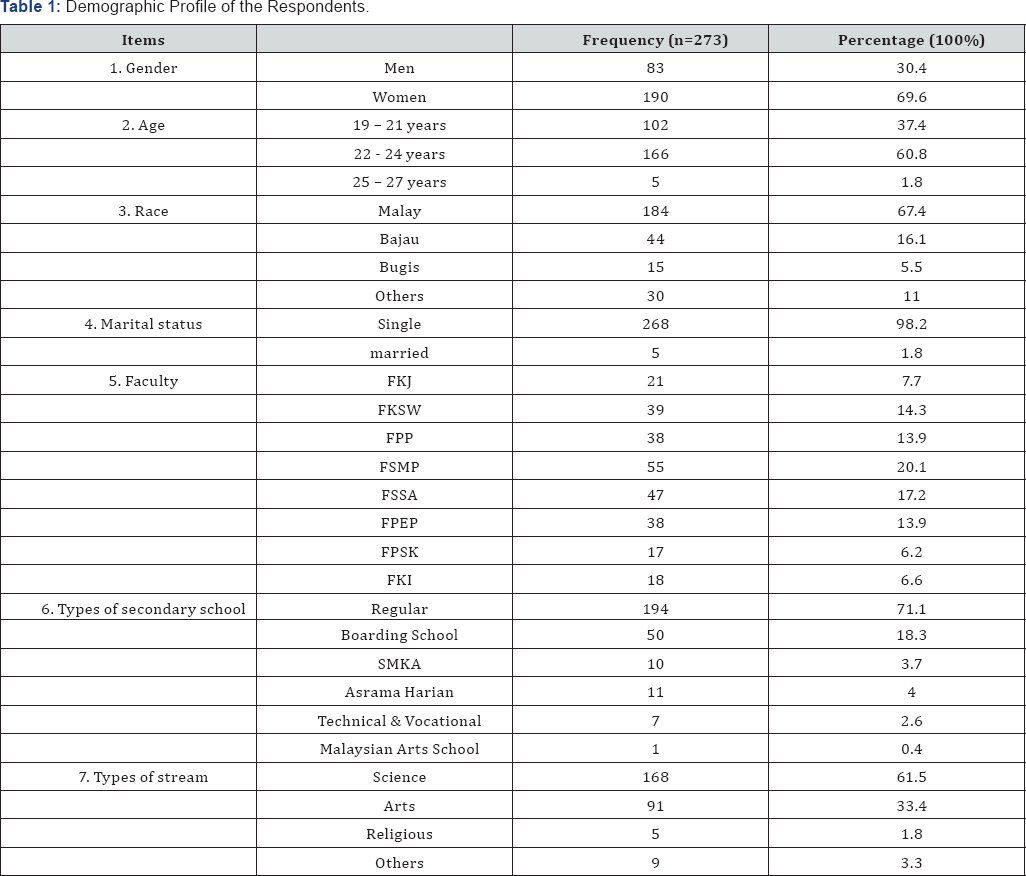
Sources of information received by the respondents on halal foods
Figure 1 presents the sources of information received by respondents on Halal foods. Majority of the respondents which were 64% agreed that internet was the main sources of Halal foods’ information. However, in one study done by Idris & Mohd Noor [5] stated that receiving information on Halal foods through internet sources showed the lowest average. Their finding showed clearly the different result because in this study, the respondents were selected among university students, which internet is one of the main medium in searching for information.
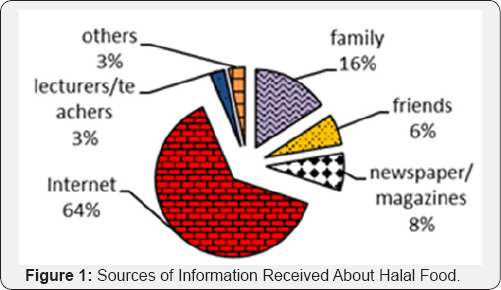
Besides, 16% respondents were received information on halal food and related to it is from their families. This percentage was the lowest distribution, showed that parents less aware on halal food to their children. According to Muhamad, this is happened because the parents themselves have less knowledge about the issues halal concept presented such as halal food in Islam, private Halal's mark, Jakim halal verification procedures, and resources, ingredients, involving the processing and production of halal food as outlined by law. There are still some people who are not serious about maintaining themselves and their families from the food concern or doubt halal (Figure 1).
Diet in Islam
Level of participants' knowledge: The levels of knowledge among participants on diet in Islam were questioned in section B. There are 14 questions in the form of par. The total overall score was translated into percentage. According to Table 3.2, it indicates that a Muslim student at the main campus of University Malaysia Sabah has a high level of knowledge about diet in Islam, namely a total of 131 people or 48%. While as many as 115 people or 42.1% of respondents have moderate knowledge level and 9.9% were in the low level of knowledge (Table 2) (Figure 2).
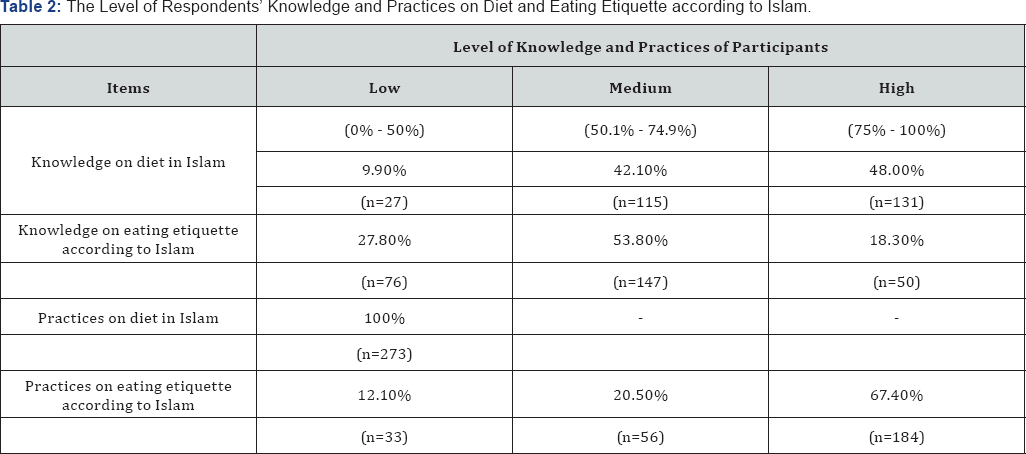
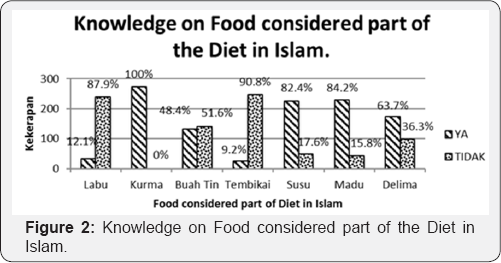
Referring to the Figure 2, 100% (n = 273) of respondents know that the dates is one of diet in Islam. The matter has been expected since the dates are some of the popular food sunnah among Muslims in Malaysia, especially during Ramadhan. Dates are fruits that are easy to eat [2]. Dates also contain a high amount of carbohydrates and easy to be absorbed by the human body [6]. According to Al-Farsi & Lee [7], dates, also known as Phoenix dactylifera scientifically composed of 70% carbohydrates, mostly in the form of sugar. The fruit is also rich in energy resources where recruitment can provide the date of 100g per 314kcal of energy.
Next, followed by 84.2% (n=230) of respondents knew that the honey belongs to the diet in Islam, milk, which accounted for 82.4% (n=225) and pomegranates of 63.7% (n=174). Meanwhile, there are only a small number of respondents know that pumpkins (12.1%) and watermelons (9.2%) are also classified according to diet in Islam.
Watermelon, also known as Citrullus Lanatus has a lot of bioactivity from natural sources such as antimicrobial, antidiabetic, and antioxidant which is more favorable than that of conventional therapies such as antihypertensive. According to Syukur [8] this fruit is easily obtained in large markets and the exportation of this fruit is increasing every year. Although this fruits are high demand, not many people know that watermelon is made up of food sunnah. This happens because of a lack of exposure of watermelon and pumpkins as a food sunnah [2].
Table 2 shows that 100% of respondents reach the level of practices of diet in Islam was low. The results of this study are consistent with previous studies in which Ishak et al. [2] found that respondents were more vulnerable, unsure and learn more about the advantages of modern food compared with the diet in Islam. The study also says that the diet sunnah scarce, too expensive, and less tasty.
There are significant differences for demographic factors such as age, faculty, type of secondary school, and type of stream. A type of secondary school and stream was expected to have significant impact on the level of knowledge about the diet according to Islam. This corresponds to the philosophy of the establishment of the National Religious Secondary Schools [9] which organized effort based on knowledge and Islamic culture to produce students, honorable, and practice the Islamic way of life and be able to contribute to the religion, nation and state (MOE 2012). In addition, there is a significant relationship between the faculties with knowledge of the diet according to Islam. Respondents among students FSMP gets the highest percentage of respondents compared with other judgments of the faculty. This is clearly because of FSMP students were exposed to the characteristics of the lawful and good food through the Food Quality and Safety subjects when in the 4th semester.
Level of participants’ practices: Although scores of respondents found satisfactory, but when seen in the practice of the respondents in accordance to Islamic dietary practices indicate that knowledge is not practicable in daily routine. This shows that although Muslim students have a high level of knowledge but not necessarily all of the knowledge it interpreted and applied to their daily lives.
Malaysian society is unusual for putting into practice some of diet according to Islam, such as figs and dates. This issue contributed to the low percentage of the practicing diet according to Islam. Furthermore, Malaysia is Asian countries are not exposed to the culture of the Arab community. Cultures of nutritional aspects include the type of, style of cooking and the types of food commonly eaten daily by the Arab community. Even the Arab countries themselves have different cultures and customs due to the different tribes and places. Those who live in Syria, for example, is not the same in many aspects with those who live in the Hijaz.
Eating etiquette according to islamic manners
Level of participants’ knowledge: According to Table 2, more than half of the total respondents, 53.8% (n = 147) achieved a moderate level of knowledge about the eating etiquette in Islam, followed by 27.8% (n = 76) of respondents are in low level and 18.3% (n=50) respondents achieve a high level of knowledge. There is several hadiths derived statement explaining the etiquette of eating a Muslim. These include:
"The believer eats with one stomach while the kafir eats with seven stomachs"
and,
"Food for one is enough for two and food for two is enough for three and food for three is enough for four." [10]
Besides, Abu Hurairah also said;
The blessings in the meal are by washing before and after it [11].
However, more than half of respondents did not know about these hadiths. This indicates a weak hadith mastery among Muslim students UMS, Kota Kinabalu. This is clearly because learning of Hadith requires observation, skills, and ongoing practical.
For this section, all the demographic factors have p values over than 0.05. There is no scientific relevance as ethical eating in Islam has been absorbed in our daily culture. The respondents were aware about the ethics of eating not because of etiquette eating is encouraged by Islam, but because it has become eating etiquette habits by respondents when eating.
Level of participants' practice: From Table 2, a total of 184 or 67.4% of the respondents have a level of eating etiquette practices in Islam was high, followed by 56% and 12.1% which were in medium and low level respectively. This indicates a high percentage of the respondents who's practicing the two ethical practices in Islam which had been studied such as washing hands before eating and moderation in eating.
Wash hands before eating has become a culture in our community where from childhood stage, parents would urge their children to wash their hands before they entertain any kind of food. Pros and the steps on properly wash hands often touted by the authorities through the mass media. This led the respondent to practice washing their hands before eating without realizing that this practice is one of eating etiquette in Islam.
For the second eating etiquette of moderation in eating, respondents were categorized according to the number of Body Mass Index (BMI) and the average food intake through Three-Day Diet Record. Respondents who had a normal BMI will be given a score and zero points for respondents who have a BMI of more than 23.0kg/m2.
As for the respondents who took the amount of energy as recommended by the Malaysian Dietary Guidelines (MDG) 2010, will be given a score and zero points for the number of respondents who take more than the recommended daily energy by age and gender. The recommended daily amount of energy for men aged 19-29 years was 2440kcal, while for women aged 19-29 years is up to 2000kcal (MDG 2010). Adequate intake of energy sources is very important because of food consumed in excess will harm the body and cause certain diseases such as laziness and fatigue [12]. Regarding to Al-adawi [13], size of the stomach is approximately 1500mm. and if divided by three, it is 500mm for each part. In addition, the third an empty stomach is very important for the human breathing because there is a relationship between the stomach and the human respiratory system (Figure 3).
Based on Figure 3 Based on this study, it was found that more than half of the respondents are in the ideal BMI category. The results are in line with research conducted by Nmor et al.[14] where there is an increasing global concern about nutrition knowledge and eating habits among university students. The same study also noted that girls are more dissatisfied about the shape and status of their weight. Therefore they are more likely to go on a diet for weight control. However, there were 40.9% and 34.2% of respondents, both men and women have a BMI that exceeds the value of the ideal BMI. According Masarudin [15] , the exercise, psychological, lifestyle, physical activity, dietary habits, heredity and genetics and is a contributor to the problem of obesity among students of UMS (Figure 4).
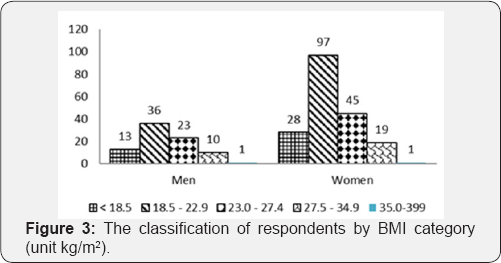
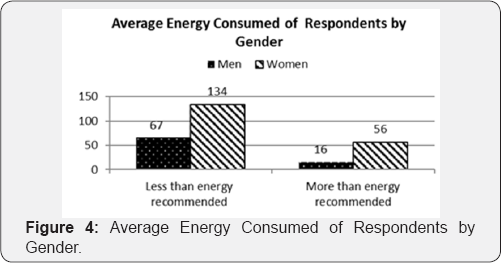
Based on Figure 4, it was found that more than 70% of respondents consumed the amount of energy as suggested. A similar survey conducted by Gan et al. [16] showed similar results, namely 65.3% female and 71.7% male students taking the total amount of energy as recommended. In fact, Ellis et al. [17] also showed that the total energy consumption by university students in the United Kingdom is 2326 kcal and 1772kcal for boys and girls. That study also believes this demonstrates a potential university student to be exposed to a positive energy balance [18-20].
In addition, the researchers argue that the lack of funding for food provided by the respondents affect their daily energy intake. This is true because the study was conducted at the beginning of the semester in which the student has not yet received financial assistance from any source such as PTPTN, JPA, and others. This corresponds to the findings by Hamdan and Clare, in which as many as 89.1% of respondents said that they would allocate some of the money they gain from either sponsored scholarships or loans to buy food. The study also noted that a majority of respondents are spending money on food in a moderate level of not more than RM10 for a day [21-].
For this finding, there are significant differences between the faculty and the respondents' practice of eating etiquette according to Islam. A respondent within FSMP students gets the highest percentage of 23.4%. This matter occurs because the students FSMP received formal education about healthy diets and the correct way in food handling.
Conclusion and Recommendation
In conclusion, although the majority of respondents achieved a high level of knowledge of diet recommended by Islam, but the practice of respondents to this diet are at a low level. This happens because the public is not familiar to practicing some diet according to Islam, which all of it came from Arabia. As for the etiquette of eating, the majorities of respondents reached the level of knowledge of eating etiquette in moderate Islam, but have a high level of ethical practice eating in Islam. This happens because the ethics of eating has become a culture without them knowing that it belongs in the dining etiquette is taught by the Prophet p.b.u.h.
For the next study, similar studies can be made to all universities/colleges in Sabah, so the findings of this study can contributes something useful in the field of research halal for Muslims in Sabah by the Faculty of Food Science and Nutrition. In addition, this study also can be extended by making scientific research on food Sunnah such as proximate analysis test. Thus, the results of the study will provide information to the Muslim community about the greatness of this diet. This study also can be expanded by adding an instrument such as using an interview method. Interviews which conducted by using good questionnaires can get a better response by respondents.
References
- Shamsuddin N, Wazir MM, Wajdi Bin FN, NoorFadhzana MN , Hafizah K, et al. (2013) Awareness and Appreciation Of Sunnah Of The Prophet Muhammad S.A.W Among Muslim Adolescents In Selangor Faculty of Education and Social Sciences, University Selangor, Malaysia.
- Mardiana MI (2013) Super Woman. PTS Millennia.
- Abdul Karim A, Nasiruddin HJ Ahmad (2014) Persoalan Sunnah Nabi SAW Di AntaraTasyri'iyyah Dan Ghayr Tasyri'iyyah Satu Analisis. Al- Bayan Journal. Department of al-Quran and al-Hadith, Academy of Islamic Studies, University of Malaya, 50603 Kuala Lumpur, Malaysia.
- Recommended Nutrient Intakes for Malaysia (2005) A Report of the Technical Working Group on Nutritional Guidelines. National Coordinating Committee on Food and Nutrition Ministry of Health Malaysia Putrajaya, Malaysia.
- Nor Aini Haji Idris, Mohd AMN (2013) Analisis Keprihatinan Pengguna Muslim Terhadap Isu Halal-Haram Produk Melalui Pembentukan Indeks. Prosiding Perkem VIII, Jilid 3: 1245-1258.
- Pamplona GD (2004) Healthy Food. San Fernando de, Spain.
- Al-Farsi, Lee CY (2008) Nutritional and functional properties of dates: a review. Crit Rev Food Sci Nutr 48(10): 877-88.
- Syukur M (2015) Semangka: Citrullus lanatus (Thunberg) Matsum & Nakai.
- SABK & SMKA (2012) dlm.
- Al-Bukhari (2011) Kumpulan hadits Shahih Al-Bukhari. Hadis no: 5392, 5394. As-Salam Publishing, Malaysia.
- Abdul Wahab AT (2010) Fikih Kuliner. Pustaka Al-Kautsar, Malaysia.
- Ann Wan S (2013) Kamu, Apa Yang kamu Makan. Kemilau Publika Sdn. Bhd.
- Al-Adawi M (2013) Makanan Sunnah Nabi: Khasiat buah-buahan, Madu, Air, dan Perubatan Nabi s.a.w. Jasmin Publications, Malaysia.
- Judith N, Harry KN, Christopher JN (2014) Eating Behaviours of University Students in Southern Nigeria: An Evaluation Of Sex Differences. Science Journal of Public Health 2(1): 23-37.
- Mas Affendi M (2006) Kekerapan Terjadinya Obesiti di Kalangan Pelajar-Pelajar Universiti Mlaysia Sabah. Tesis Sarjana Muda. Universiti Malaysia Sabah, Malaysia.
- Gan WY, Mohd NM, Zalilah MS, Hazizi AS (2011) Differences in eating behaviours, dietary intake and body weight status between male and female Malaysian University students. Malays J Nutr 17(2): 213-218.
- Ellis J, Costa R, Amir abdollahian F (2012) An Investigation into Energy Balance And Macronutrient Intakes Of University Students. Proceedings of the Nutrition Society, UK.
- Abdul Rahim H, Clare S (2010) Amalan Pemakanan Di Kalangan Pelajar Tahun 4 SPH Fakulti Pendidikan. Fakulti Pendidikan. Universiti Teknologi Malaysia.
- Ahmad JS, Abdul RH, Jamaluddin R, dan Nor Salis S (2006) Pengaruh pengetahuan Agama ke atas Amalan dan Gaya Hidup Mahasiswa Islam Universiti Teknologi Malaysia. Fakulti Pendidikan, Universiti Teknologi, Malaysia.
- Al-Quran Tajwid dan T (2010) Humaira Bookstore Enterprise, Malaysia.
- Amiruddin Mohd S, Norazman A, Zulhilmi Mohamed N, Ahmad Sanusi A (2011) Metodologi Pengajian Ulum Al-Hadith: Antara Keperluan Penghafalan Matan (Mustalah Al-Hadith) Dengan Pengajaran Secara Moden. Seminar MUSNAD: Seminar Antarabangsa: Sunnah Nabawiyyah: Realiti dan Cabaran Semasa, Malaysia.
- Bande YM, Adam NM, Jamarei BO, Azmi Y Zubairu UB (2013) Egusi melon (Citrullus lanatus) crop -Malaysian new oil/energy source: Production, processing and prospects. Australian Journal of Crop Science 7(13): 21012107.
- Golnaz R, Zainal abidin M, Mad Nasir S, Eddie Chiew, FC (2010) Non Muslims' awareness of Halal principles and related food products in Malaysia. International Food Research Journal.17: 667-674.
- Mohd Shuhaimi Bin HIK, Nurul Fadzlin Binti Che S, Siti Nazirah BY, Siti Nabilah Binti MT (2013) Muslim Youths'Perception on Sunnah Diet: A Survey on IIUM Students. International Islamic University Malaysia, Jalan Gombak, Malaysia.
- Najamuddin M (2013) Mukjizat Makanan dan Minuman Kesukaan Rasulullah s.a.w. Sekaligus Manfaatnya. Al Hidayah House of Publishers Sdn. Bhd, Malaysia.
- Henares Madrid RS, Poh BK, Mohd Ismail N (2013) RPengetahuan PemakanandanPengambilan Suplemen dalam Kalangan Anggota Tentera Laut Diraja Malaysia. Sains Malaysiana 42(8): 1181-1190.
- Siti Norlina M, Zamzarina CM, Maznah A, Zulkifli H, Mohd Nasir R, et al. (2005) Kecenderungan Ibubapa MuslimTerhadap Pemakanan Halal: Kajian di Skudai, Johor Bahru, Johor. Pusat PengajianIslamDan Pembangunan Sosial, Universiti Teknologi Malaysia, Malaysia.






























